Latest News
December 1, 2004
By Stephen Samuel
The difficulty in estimating a design job is due in large part to therole your CAD program plays. Since CAD is a huge multiplier of all thegood and bad that engineers do, it can either be a great timesaver or atremendous waster of it when not applied properly. Therefore, thedifference between your estimated time and the actual time it takes tocomplete the project has the potential to be much greater than it wasbefore you went to a CAD solution to make more efficient use of yourtime. The problem is exacerbated by the fact that many of the peoplewho quote jobs are not necessarily experienced CAD users. To solve thisproblem, Design Visionaries of San Jose, CA, has created a toolcalled the Design Project Estimation Tool (DPET). It is available toall visitors to the Design Visionaries website by clicking on theGoodies button at the top of the homepage at designviz.com.
Estimating the time and cost of your engineering project can be verydifficult, yet it remains critical to your company’s success. If youconsistently underestimate, you will spend more than you make andeventually go bankrupt. If you consistently overestimate, you will loseall business to your competition and won’t make any money to beginwith. Neither result is acceptable.

The DPET was developed using our experience in the critical factorsrelated to CAD that determine modern design project schedules. The toolis detailed below:
The first section of the DPET (shown above) deals with variables that requirespecific consideration, such as (single) user skill level. Somejudgment is required here. For example, the skill level check box canbe interpreted as being relative to CAD tool use, experience in theindustry, familiarity with processes, or other critical factor ofinterest to the calculator user. In its entirety, the calculator isdesigned to account for the project work of a homogenous staff withskill set differences as accounted for in the first input section. Thecalculator can be run for each additional team member, combiningseparate totals for the aggregate project time.
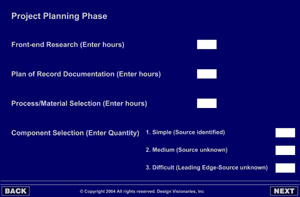
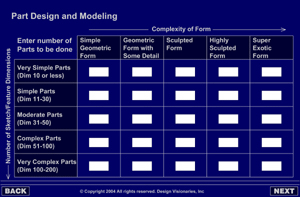
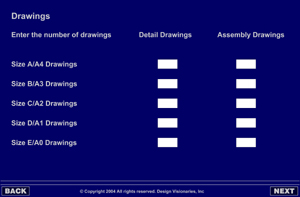
Section four (shown above) has built-in factors to improve accuracy in computingthetime it will take for part and assembly drawing creation. DPET is wiredto account for electronic data transfer-type documents to fullydimensioned documents with tolerance analyses included.
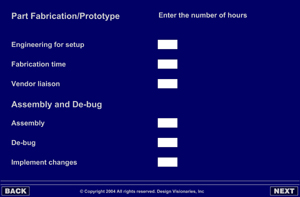
Section five (above) and six (below), dealing withpart fabrication, prototyping andassembly, and de-bugging, simply asks for hours to be entered. Thoughthese tasks will not likely comprise a large portion of the project’stotal time expenditure, if the project task list includes fabricationand assembly, an accounting here will increase estimate accuracy. Ifthere is no requirement for assembly and de-bug, and other tasks areenvisioned that are not listed within the calculator, sections five andsix can be used to account for them instead.Once the sections are completed, thefinal section shows the totalcalculated project time in hours, days, and weeks. In just a fewminutes, and with a small amount of consideration as to project tasks,you get a reasonably accurate estimate of your project time.
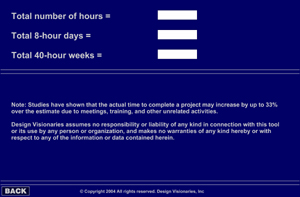
Stephen Samuel is president of Design Visionaries. You can e-mail himwith suggestions, additions, or improvements to the DPET at [email protected].
Subscribe to our FREE magazine, FREE email newsletters or both!
Latest News
About the Author
DE’s editors contribute news and new product announcements to Digital Engineering.
Press releases may be sent to them via [email protected].






